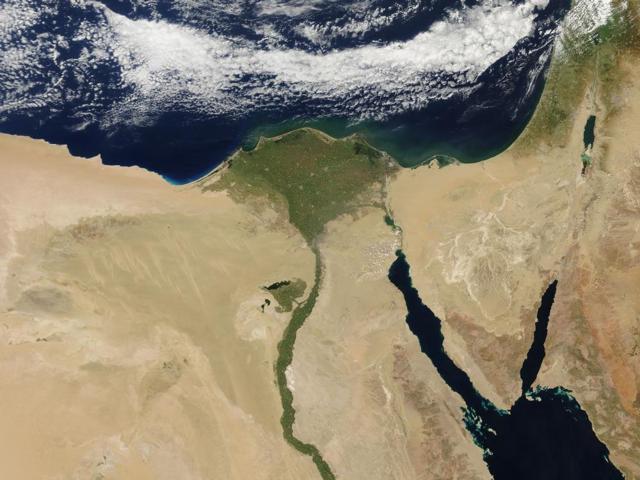Changes in the Nile River flow
Today I’ll be looking at the example of the Nile River to show how water dependency and climate change in Africa might look like in the future.
As the Nile is the longest river in the world it is most certain that whatever consequences climate change might have on it humanity will surely be affected by it.
The Nile River can be separated into several parts that contribute to the overall river flow. The Upper Blue Nile contains about 56% of the total water flow whereas the Eastern Nile only accounts for 24%. In total there are more parts the river can be distributed into but for now these two will be focused on as they will be relevant for the following considerations.
The picture shows the Nile Delta in northern Egypt flowing into the Mediterranean Sea.
The Nile River flows through a total of eleven countries and about 400 million people are dependent on the Nile River basin. This is due to most of these countries having an economy largely focused on agriculture. Therefore they are reliant on irrigation and water supply coming from the Nile river. The conclusion is that there is already quite a high water stress but this might be intensified in the future to to environmental changes caused by climate change.
Moreover the Nile River flow as well as the rainfall in the basin area are very seasonal with a peak in the late boreal summer. This variability of the river discharge only increases the water stress in the area and the need for water storage and water regulation through dams for instance.
The amount of water flow is also influenced by the El Niño Southern Oscillation also called ENSO.
It occurs every few years in the tropical Pacific Ocean and got an opponent called La Niña. So during an El Niño event the Nile River basin has a tendency to get drier. Studies show that the ENSO is responsible for about 27% of the Nile River water flow variability.
In the last few years there have been lots of discussions around Ethiopia building the Grand Ethiopian Renaissance Dam (GERD) on the Blue Nile. As I stated before this is the part of the Nile which contributes most of the water for the overall river flow so this could potentially be most problematic for the downstream countries such as Sudan and Egypt. These countries are largely dependent on the water of the Nile River for their freshwater supply and it is a very political issue for these countries to still get an equal amount of water after the GERD will have been build. Furthermore the dam is also bigger than any other dam that has been build before on the Nile River so it gets even more worrying.
As if all of this wouldn’t be problematic enough and there is also the influence climate change will have on the Nile River basin. There have been studies based on different Global Climate Models (GCMs) which try to predict the future annual river flow as well as the change in flow variability. However there seems to be some disagreement between the predictions based on different GCMs. Due to this inconsistency it seems very hard to make a general prediction of how the Nile River is going to be influenced by climate change.
The thing that has been largely consensus though is that there will be an increase in the variability of the Nile River. This is supported by studies showing that over the last 50 years the river flow of the nile basin has also been changing with a tendency go the mean and standard deviation to increase. This trend seems to continue till at least 2040. It is predicted to come to a halt at that time as there is a predicted weakening of the walker circulation which has a large influence on the river flow.
In detail the storage capacity of the Nile River is predicted to increase by 33% and the mean flow will increase from 80km3 yr−1 to 92km3 yr−1. And if GERD is build the total storage capacity is expected to increase from 155km3 to 230km3.
So due to the increase in variability there is need for additional storage capacity. However according to evaluations the variability should match the flow extensions for the next 40 years and if GERD is build it will be for the next 60 years. Afterwards there might be a need for more storage capacity. This is to capture the additional flow that will be created by the enhanced interannual variability due to climate change. A possibility for that might be to build more dams like GERD which requires agreements between the countries as well as suitable sites for dams. However in order to plan this there is definitely a need for more research in order to have more detailed and precise predictions on how the future river flows might look like.

Comments
Post a Comment